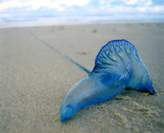Bluebottles

I am always worried about bluebottles. One day, I decided that the water looked great and headed out on my board, only to be surrounded by massive blue sacs floating on the water - or bluebottles. I immediately exited the water without being stung.
Bluebottle stings are the worst! I've been stung a number of times during the ocean swim events that I participate in.
Nowadays, I always check the surf-report to make sure that the beach is unlikely to wash up bluebottles. My local beaches: North Gong or Bellambi are both North-east facing and therefore are prone to bluebottles on a North-easterly wind. This is what I've learned.
what are they and where do they come from?
Bluebottles love warm water and so they originate from the North. They are only found in the Indian and Pacific Ocean, which is probaby why travellers or immigrants stung on the beach during summer report a jelly fish sting—they have never seen them before. Bluebottles are siphonophores and are not jellyfish but they are close relatives.
They are usually found on exposed ocean beaches, rather than in sheltered waters, and are washed up through strong North-easterly or South-easterly winds. Bluebottles are not always blown onto shore, as they can be pushed around 50⁰ left or right of the wind direction. Therefore, while it is dependent on the wind, there are also other factors at play.
How to treat a sting?
It was funny, on Australia day 2023, at least 5 people came up to me when I was patrolling North Wollongong Beach to complain of a nasty sting. I said to one woman "you must have been stung by a bluebottle, quite common in a North-easterly swell". She was flabbergasted. "what is a bluebottIe? Am I in danger?" No not in danger, but it can be painful.
You know you have been stung if you feel an immediate intense and local pain. It can last for up to an hour but usually subsides. Afterwards, the skin may be marked with a raised red line - chaffing
Did you know that actually the way to treat a bluebottle sting is with hot water and not cold? There was a study conducted to show that it decreases the pain significantly more than cold water, while the reason is unknown, it could just be a neurological reason i.e. damping our pain-receptors?
Do you see a bluebottle dead on the beach? Do not touch it as it can still sting you.
Fun facts about bluebottles
- Blue bottles, while they look like individual creatures, are actually made up of a colony
- The colony as an individual, reproduces with itself? They can form their own eggs and sperm to produce larvae.
- They have a sac fills with gas (air) which allows it to float - called the float
- The float, or sac, supports the colony and can grow up to 15cm. These floats can lean to the left or right – a design believed to be the marine stinger’s way of ensuring that only part of a population is blown into shore and stranded during certain wind conditions.